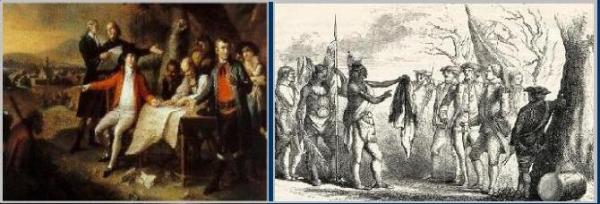

Georgia was the last American colony and founded 50 years after the initial twelve. It was named for King George II who granted a 21 year charter to a board of 21 trustees for the land between the Savannah and Altamaha rivers and westward to the “South Sea.” James Oglethorpe, its founder and governor, was a member of Parliament as well as a reformer who was concerned about the atrocious conditions of the grim debtors prisons. He resolved to ship their inmates to America instead.
Oglethorpe enlisted prominent men to lead and establish the new colony, both to give the needy a new start in life and to extend British dominions. The applicants were examined for honesty and “inability for English livelihood.” Over the period of the trusteeship (1732-1755), fifty more trustees were added. Oglethorpe points at his colony, above
Thirty-seven Salzburger families bound for America proceeded to Dover, England and swore allegiance to King George and were awarded the same rights of Englishmen bound for an English Colony. On January 8, 1734, a year after arriving in England, the Salzburgers began their stormy 63 day journey to Georgia on a two hundred ton ship named the ‘Purysburg’ under Captain Tobias Pry. On March 12, 1734, their ship arrived at the Savannah River and was met by Oglethorpe who led them to their new home. Oglethorpe named the town, its stream and the Parish, Ebenezer. Salzburgers were Georgia’s first religious refugees.
The Salzburgers occupied approximately 25 square miles on the eastern side of Effingham County. By the fall of 1737, many farmsteads had also been established on the Mill Creek bluff, also known as Abercorn Creek.
This area became known as the Mill District after several mills were founded: the first grist mill, first rice mill and the first saw mill in the colony. The Salzburgers also had a silk business and built the market squares in Savannah to sell their wares. They opened the first schools and the first orphanage in the colony. Cultural solidarity characterized the colony’s first 30 years, during which time, the settlements retained a strong German identity.
The Salzburgers built the permanent Jerusalem Lutheran Church, in 1769 with 21-inches thick walls made of handmade brick created from Georgia clay fired in a nearby kiln, and some bricks on the front of the church still bear the fingerprints of Salzburger children who helped mold and carry them. The bells adorned the church and rang every Sunday.
In 1765, there were about 1,050 residents in Ebenezer and its communities, but the population began to fragment, a sad state further exacerbated by the events of the American Revolution. During the Revolutionary War, the British occupied Ebenezer and plundered and burned the town. Troops seized the Salzburgers’ possessions, ruined their gardens and chased out and terrorized the people. They used the old church as a hospital, a storehouse and as a holding center for prisoners. Finally, as they realized that England was losing the war, they spitefully used the brick-floored church as a stable for their horses. They burned the pews, hymnals, Bibles, library and copies of daily journals of its pastors. One especially bitter British soldier fired a round through the swan weathervane on the church steeple, which had survived an ocean voyage from the Old World.
When the Patriots under General “Mad” Anthony Wayne drove the British out in 1782, church members immediately cleaned and repaired their church and resumed worship. The Georgia Legislature also met in the church and named Ebenezer the Capital of Georgia for two weeks (this makes this church the oldest “public building” in Georgia).
The Georgia Germans were pressured to assimilate after the Revolution, and many surnames were Anglicized and no longer German. Sadly, with their beloved town in ruins, most of the Salzburgers found new homes elsewhere. By 1782, most of the colonial Salzburger settlements were abandoned and were essentially ghost towns. After an interval, Georgia was reorganized, whereupon some new growth, already begun in response to the trustee’s relaxations, put the colony on a more prosperous footing. But 2,000 residents had relocated, New Ebenezer declined even more until 1855, when it all but vanished. Many had not gone too terribly far and were still able to visit the church on Sundays, so the church remained active.
Alas, there were more hard times to come for Ebenezer during the Civil War when Federal troops occupied the church, once again using its picket fence, Bibles and hymnals for fires and engaging in skirmishes on the grounds. The Church is an amazing testament to survival, both of villains and of heroes. Up until 1803, all services were still conducted in German. The church, along with the cemetery and one home, are all that remain from the original community today. A small group of descendants continue to worship in the brick church, giving Jerusalem Lutheran Church the longest continual congregation in America, and the oldest church bells in Georgia still ringing from its heights.